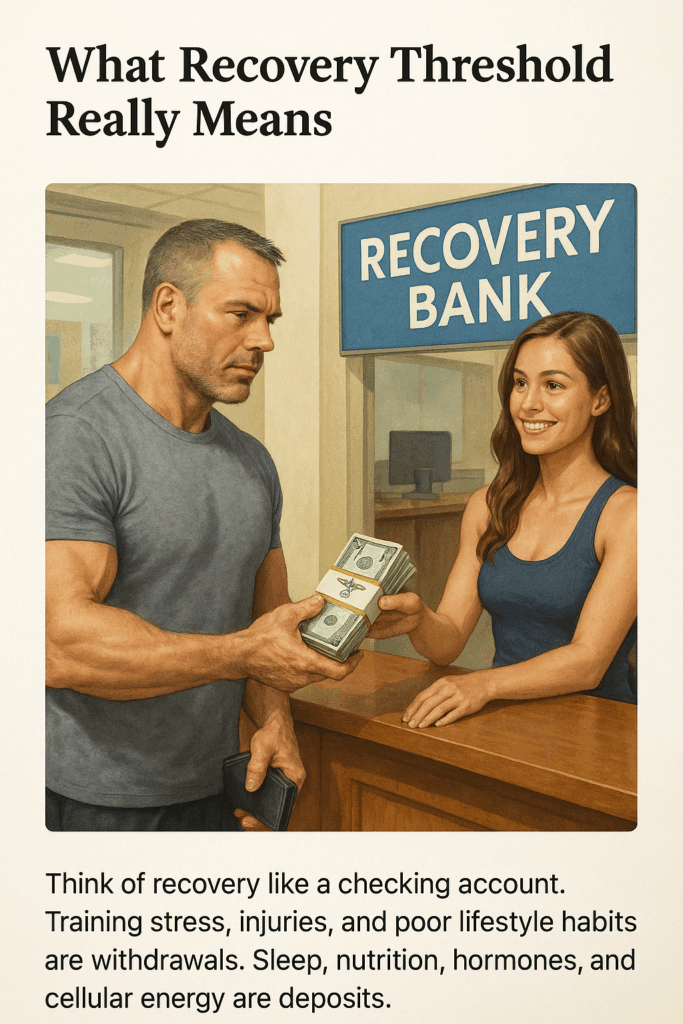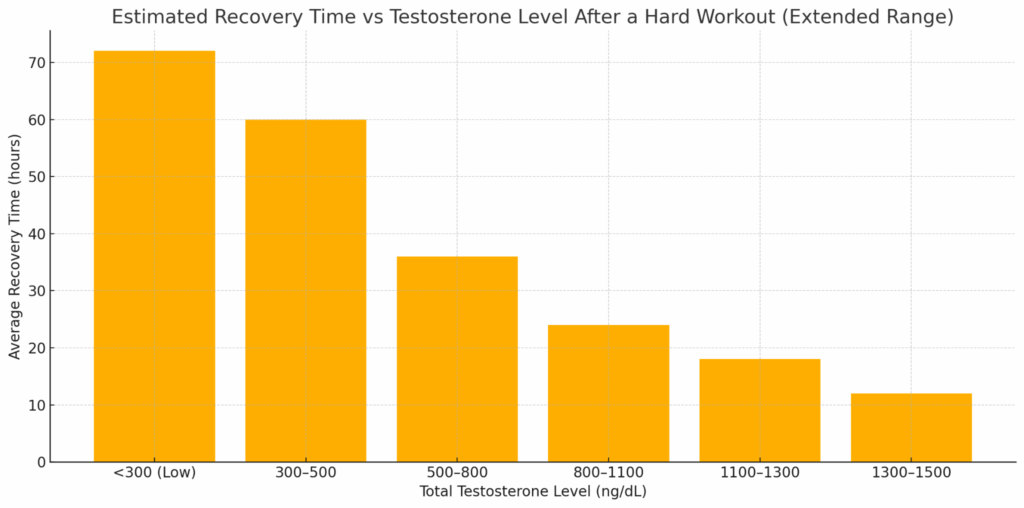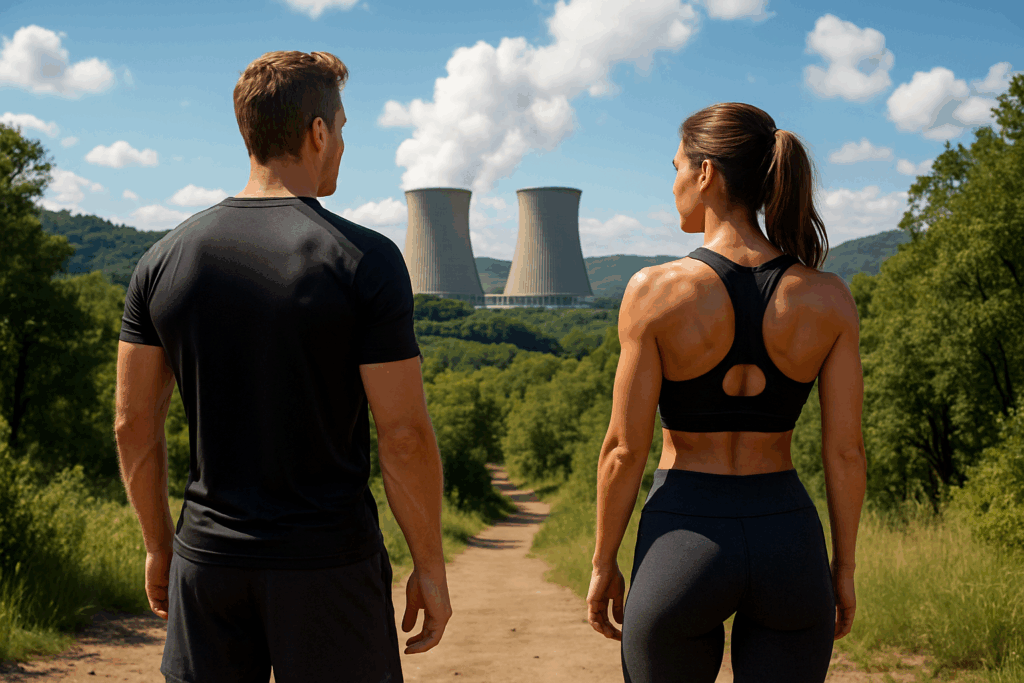How TRT, Growth Hormone, and Peptides Help Athletes Heal Faster
Executive Summary
Some injuries heal fast. Others drag on forever or never quite go away. The difference often comes down to your Recovery Threshold — the point where your body either has the resources to repair damage or it doesn’t.
That threshold gets lower with age, stress, and poor sleep. But it can be raised. Testosterone replacement therapy (TRT), growth hormone boosters like CJC-1295 and Ipamorelin, and healing peptides such as Thymosin Beta-4 , BPC-157, MOTS-c, and NAD⁺ can all expand your body’s ability to heal, handle bigger training loads, prevent injuries from occurring in the first place, or nagging injuries from turning chronic.
What Recovery Threshold Really Means
Think of recovery like a checking account. Training stress, injuries, and poor lifestyle habits are withdrawals. Sleep, nutrition, hormones, and cellular energy are deposits.

If you’ve got money in the account, you heal. If you’re overdrawn, you don’t — and the damage just lingers. That’s why small injuries in your 20s can bounce back quickly, but the same tweaks in your 40s hang around for months.
Why Healing Slows as We Age
The older you get, the smaller your “healing budget”:
- Testosterone drops by about 1% per year after 30, slowing protein synthesis and muscle repair.
- Growth hormone and IGF-1 decline even faster, which hurts collagen turnover — the backbone of tendon and ligament repair.
- Mitochondria wear down, leaving you with less cellular energy for recovery.
- Chronic inflammation rises, eating into whatever resources you do have.
Combine that with accumulated micro-injuries, and the margin for error shrinks fast.
Stress and Sleep: The Hidden Threshold Killers
It’s not just aging. Even younger athletes can burn through their threshold if they aren’t careful.

- One night of fewer than 5 hours of sleep can cut testosterone by 10–15%.
- High stress drives cortisol up, which literally breaks down muscle tissue.
- Poor nutrition leaves your body without the raw materials for healing.
Ignore these basics, and even the best peptide stack won’t save you.
Testosterone: Powerful but Not the Whole Answer
TRT is well-known for building muscle, but it also plays a role in recovery.

- In a landmark trial, men given high doses of testosterone added lean mass and strength in just 10 weeks.¹
- In older men, testosterone therapy improved muscle performance and physical function within 12–16 weeks, peaking by 6–12 months.²,³
But there’s a catch: muscle adapts faster than tendons. Some studies show men on TRT alone actually have higher tendon injury rates.⁴ That’s because testosterone ramps up muscle power without fixing the connective-tissue lag.
Growth Hormone: Balancing the Equation
That’s where growth hormone (GH) comes in. GH and its partner IGF-1 drive collagen turnover and connective tissue strength. Without them, tendons can’t keep up.
- CJC-1295 raises GH and IGF-1 levels for several days at a time.⁵
- Ipamorelin delivers short, clean GH pulses without the side effects older peptides had.⁶,⁷
Stacked together, they create a more youthful hormone profile: CJC-1295 sets the baseline, Ipamorelin adds the natural pulses. This keeps tendons and ligaments adapting at the same pace as your stronger muscles.
Peptides That Fine-Tune Repair
Thymosin Beta-4 (TB-4) and TB-500
TB-4 is the parent peptide, and TB-500 is its stable, synthetic fragment. Both are heavily studied in tissue repair.
- Animal studies show 25–30% faster wound closure and improved blood vessel growth with TB-4.⁸
- TB-500 helps cells migrate and reorganize after damage, making it a useful complement to TB-4.
BPC-157 This gastric peptide has an impressive healing profile in preclinical studies.
- In animal models, it sped up tendon-to-bone healing by 25–30%.⁹
- It also stimulated fibroblast growth — the cells that actually rebuild tendon tissue.¹⁰
MOTS-c and NAD⁺: The Energy Amplifiers
Repair signals are useless if cells don’t have energy. This is where MOTS-c and NAD⁺ shine.
MOTS-c, a mitochondrial peptide, boosts cellular energy efficiency. In mice, it increased running endurance by 15–20%, and in humans it’s released during exercise to improve resilience.¹¹,¹²
NAD⁺ is a cofactor that declines with age. Restoring it improves mitochondrial output and stem cell function, which means your body has more raw energy to fuel repair.

Together, MOTS-c and NAD⁺ raise the “energy floor” of recovery. That makes hormones like TRT and GH — and peptides like TB-4 and BPC-157 — more effective, because the body now has both the signal to repair and the energy to make it happen.
Real-World Note
My own experience with recovery threshold happened just after I turned 50 and was coming off a triathlon season. From January through May, I fought a persistent burning, itching sensation in my right Achilles tendon that just wouldn’t go away. I tried all the usual remedies — rest, massage, NSAIDs — with zero effect. A gym buddy shared how peptides healed his shoulder, and after doing extensive research, I started a regimen of BPC-157, TB-4, Ipamorelin, and GHK-Cu. Just five days later the burning and itching were gone. Within a few weeks the tendon felt solid; by week five I was back to running, and by week seven I raced on it pain-free. That Achilles has been trouble-free ever since, and now I routinely use peptides in my training blocks to train harder and stay injury-free.
Practical Cycling: Raising Threshold While Staying Consistent
Base Block (8–12 weeks)
- CJC-1295 + Ipamorelin for GH support.
- MOTS-c 2–3×/week + NAD⁺ precursors (NR or NMN daily) for mitochondrial energy.
Intensification (4–6 weeks)
- Add Ipamorelin pre-session for GH spikes on hard days.
- Short cycles of BPC-157 or TB-4/TB-500 to protect vulnerable tissues.
Rebuild (2–4 weeks)
- Taper GH secretagogues.
- Continue NAD⁺ + MOTS-c to sustain systemic energy.
- Use BPC-157 spot cycles for lingering trouble spots.
The Long Game
Raising your recovery threshold isn’t just about healing injuries faster — it’s about staying in the game longer. Over months and years:
- You miss fewer sessions, stacking more consistent training.
- You avoid chronic breakdowns, since tendons and ligaments keep pace with muscle.
- You resist burnout, both physical and mental.
- You extend your career, training and competing at a high level into your 40s, 50s, and beyond.
MOTS-c and NAD⁺ make all of this work better, by fueling the entire system from the ground up. They don’t replace TRT, GH, or healing peptides — they amplify them.
References
- Bhasin S, Storer TW, Berman N, et al. The effects of supraphysiologic doses of testosterone on muscle size and strength in normal men. N Engl J Med. 1996;335(1):1-7.
- Saad F, Aversa A, Isidori AM, et al. Onset of effects of testosterone treatment and time span until maximum effects are achieved. Eur J Endocrinol. 2011;165(5):675-685.
- LeBrasseur NK, Bhasin S, Miciek R, et al. Effects of testosterone therapy on muscle performance and physical function in older men: a randomized controlled trial. J Gerontol A Biol Sci Med Sci. 2008;63(11):1155-1160.
- Albright JA, et al. Testosterone replacement therapy is associated with increased odds of Achilles tendon injury. Orthop J Sports Med. 2023;11(10):23259671231201924.
- Teichman SL, Neale A, Lawrence B, et al. Prolonged stimulation of GH and IGF-I by CJC-1295, a long-acting GHRH analog, in healthy adults. J Clin Endocrinol Metab. 2006;91(3):799-805.
- Gobburu JVS, Fink RS, Sweeney K, et al. Pharmacokinetic-pharmacodynamic modeling of ipamorelin, a GH-releasing peptide, in healthy volunteers. Pharm Res. 1999;16(9):1412-1416.
- Raun K, Hansen BS, Johansen PB, et al. Ipamorelin, the first selective growth hormone secretagogue. Eur J Endocrinol. 1998;139(5):552-561.
- Lv S, et al. Thymosin-β4 induces angiogenesis in critical limb ischemia mice. Exp Ther Med. 2020;20(2):1327-1336.
- Staresinic M, et al. Gastric pentadecapeptide BPC-157 accelerates healing of transected rat Achilles tendon and stimulates tendocyte growth. J Orthop Res. 2003;21(6):976-983.
- Chang CH, et al. Promoting effect of BPC-157 on tendon fibroblast outgrowth and cell survival. J Appl Physiol. 2011;110(3):774-780.
- Reynolds JC, et al. MOTS-c is an exercise-induced mitochondrial-encoded regulator that enhances physical performance and metabolic resilience. Nat Commun. 2021;12:705.
- Yoon TK, et al. Exercise, mitohormesis, and MOTS-c: mechanisms and implications. Antioxidants (Basel). 2022;11(6):1107.